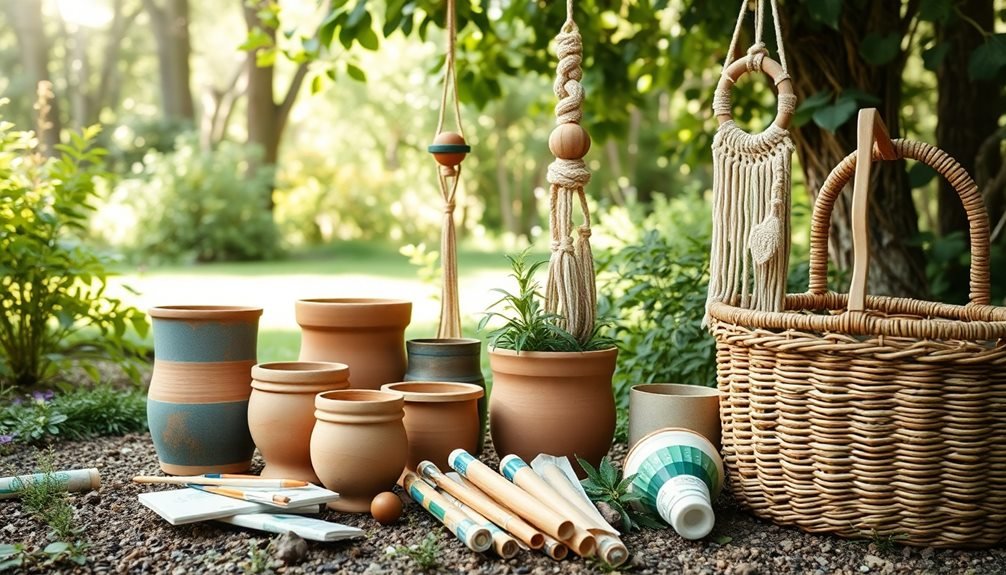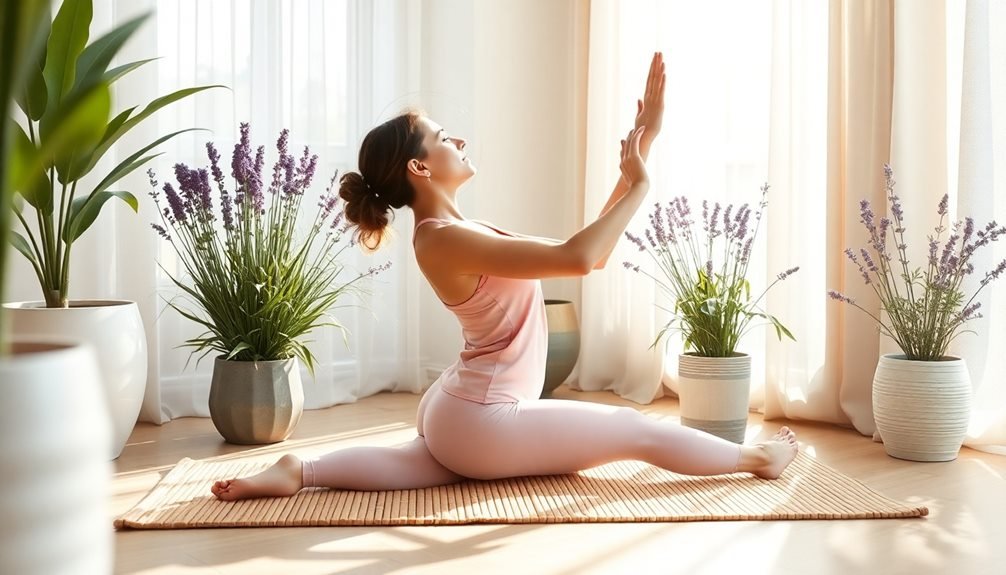Garden crafts offer a powerful antidote to anxiety through multiple therapeutic pathways. When you work with soil, you're exposed to natural antidepressants like Mycobacterium vaccae, while the rhythmic motions of crafting activate your body's relaxation response. Painting rocks, creating wind chimes, or tending to herbs combines creative expression with nature's calming effects, boosting your serotonin levels and reducing stress hormones. You'll find that recycling materials and collecting natural elements for projects helps ground you in the present moment, while the repetitive actions lower your heart rate and blood pressure. Discover how these simple activities can transform your garden into a sanctuary of peace and mindfulness.
The Science Behind Garden Therapy

Three key scientific principles explain why gardening effectively reduces anxiety.
First, working with soil releases beneficial microorganisms that trigger serotonin production in your brain. When you dig, plant, or handle earth, you're exposed to Mycobacterium vaccae, a natural antidepressant that elevates your mood and reduces stress hormones like cortisol.
Second, the repetitive motions involved in garden crafts activate your parasympathetic nervous system. Whether you're weaving plant fibers, arranging flowers, or pressing leaves, these rhythmic movements lower your heart rate and blood pressure. Your brain shifts from "fight or flight" to a calmer "rest and digest" state.
Third, engaging with nature triggers attention restoration theory (ART) in action. Your brain uses two types of attention: directed attention, which requires mental effort, and involuntary attention, which doesn't deplete mental energy.
Garden crafts engage your involuntary attention through natural elements, allowing your directed attention systems to rest and recover. This mental restoration explains why you'll feel more focused and less anxious after spending time with garden-based activities.
Simple Garden Craft Supplies
You'll need just a few basic tools to start garden crafting: pruning shears, twine, and a good pair of scissors will handle most projects.
Your craft supplies can come from items you'd normally throw away, like glass jars, tin cans, and plastic containers that make perfect planters and organizers.
The best crafting materials are often right in your garden, including pinecones, dried flowers, leaves, and twigs that you can gather during your therapeutic outdoor time.
Basic Tools You Need
Getting started with garden crafts requires just a few basic supplies that you likely have around the house.
You'll need a sharp pair of pruning shears for cutting stems and branches, plus regular scissors for trimming ribbon, twine, and other craft materials. A utility knife comes in handy for detailed cutting work, while pliers help bend wire and manipulate metal elements.
Keep a collection of containers ready – clean glass jars, terra cotta pots, and baskets work perfectly for most projects.
You'll also want a reliable hot glue gun with extra glue sticks for securing decorative elements. Don't forget basic gardening tools like a small trowel and hand rake for working with soil and plants.
For protecting your work surface and clothes, grab an old sheet or dropcloth, and wear a sturdy apron.
You'll need work gloves in two varieties: garden gloves for handling plants and soil, and thin cotton gloves for delicate craft work.
Consider adding a spray bottle for misting plants and a measuring tape for precise measurements.
Store these tools in a portable caddy or box, so you're always ready to start creating.
Recycled Materials Work Best
Resourceful gardeners know that everyday recyclables make excellent supplies for garden crafts. You'll find many of these items right in your home: plastic containers, glass jars, tin cans, cardboard boxes, and old newspapers. These materials are perfect for creating plant markers, seed starters, and decorative garden features while saving money and reducing waste.
Your kitchen's empty yogurt containers can become seedling pots, while glass jars transform into beautiful terrariums or candle holders for evening garden ambiance. Tin cans, once cleaned and painted, make charming planters or wind chimes.
Old newspapers serve multiple purposes – from crafting biodegradable seed pots to creating paper mâché garden ornaments.
Don't overlook items like broken pottery, which you can use for mosaic stepping stones, or wine bottles that become garden border edging. Empty milk jugs work perfectly as watering cans or mini-greenhouses for delicate plants.
Even worn-out rubber boots and wooden pallets can find new life as unique planters. By repurposing these materials, you're not just creating meaningful garden art – you're also practicing mindfulness through sustainable crafting, which can greatly reduce anxiety.
Natural Crafting Elements Found
Beyond recycled materials, nature itself provides an abundant supply of crafting elements right in your garden. You'll find an array of fallen leaves, twigs, stones, pinecones, and seed pods that can transform into beautiful craft projects. These natural elements don't cost anything and connect you directly to the seasonal changes in your outdoor space.
Look for smooth river rocks to paint or stack, and collect sturdy branches to create garden markers or small trellises. Dried flowers and leaves work perfectly for pressing between books to make botanical art or handmade cards. You can gather acorns, chestnuts, and other tree nuts to craft seasonal decorations or natural jewelry.
Pine needles can be woven into small baskets, while bark pieces become rustic picture frames or plant markers. Don't overlook the creative potential of moss, lichens, and dried grasses – they're excellent for adding texture to wreaths and fairy gardens.
Even fallen petals can be dried and used in potpourri or preserved in clear resin to make unique pendants. Remember to collect these items responsibly, taking only what you need and leaving enough for local wildlife.
Mindful Garden Rock Painting

You'll need just a few basic supplies to begin rock painting: smooth stones, acrylic paint, and brushes.
As you paint patterns, shapes, or words on your chosen rocks, let your mind focus on each brushstroke while releasing daily stress.
Once complete, place your painted creations throughout your garden as colorful reminders to pause and breathe.
Simple Supplies Needed First
Just a handful of basic supplies will get you started with mindful rock painting for your garden.
You'll need smooth rocks of various sizes, which you can collect from your yard or purchase from a garden center. Choose acrylic paints in your preferred colors, as they're weather-resistant and adhere well to stone surfaces. Pick up a set of paintbrushes in different sizes, including fine-tipped ones for details and wider brushes for background coverage.
Don't forget a clear sealer to protect your finished work from rain and sun damage. You'll also want paper towels for cleanup, a cup of water for rinsing brushes, and a paint palette or paper plate for mixing colors.
Consider adding optional supplies like paint pens for precise details, stencils for patterns, and a pencil to sketch designs before painting.
Set up your workspace with newspaper or a drop cloth to protect surfaces, and make sure you've got good lighting. Keep a small spray bottle of water nearby to keep paints from drying out while you work.
These basic materials will facilitate hours of mindful creativity in your garden craft practice.
Paint With Peaceful Purpose
Through mindful rock painting, you'll transform simple stones into colorful expressions of peace and serenity. As you select each rock, feel its texture and weight in your palm, connecting with its natural form before adding your personal touch. Choose calming colors like soft blues, gentle greens, or warm purples that speak to your soul and promote tranquility.
Start by cleaning your chosen rocks with water and letting them dry completely. Apply a base coat of acrylic paint, taking slow, deliberate strokes while focusing on your breathing. As you layer colors and patterns, let your mind drift away from daily worries. Paint simple mandalas, peaceful words, or nature-inspired designs that bring you joy.
Don't worry about perfection – embrace any imperfections as part of your mindful journey. Once you've finished painting, seal your rocks with clear protective spray to preserve your artwork.
Place these painted companions throughout your garden as reminders to pause and breathe. You can also create a meditation circle with your painted rocks, arranging them in a pattern that grounds you during anxious moments. Each painted rock becomes a tangible reminder to stay present and find peace in your garden sanctuary.
Display Your Garden Treasures
With your collection of mindfully painted rocks complete, finding the perfect display spots in your garden becomes its own meditative practice. Each painted stone carries its own energy and meaning, deserving thoughtful placement that enhances both your garden's aesthetic and your emotional connection to the space.
| Location | Purpose | Benefits |
|---|---|---|
| Path Edges | Guide visitors | Creates flow and direction |
| Near Plants | Accent flowers | Adds color year-round |
| Water Features | Enhance tranquility | Reflects light and movement |
| Meditation Spots | Focus attention | Centers your thoughts |
| Garden Corners | Define spaces | Establishes boundaries |
You'll find that arranging your painted rocks isn't just about decoration—it's about creating mindful moments throughout your garden. Consider placing calming blue stones near water features, energetic yellows alongside sunny flowers, and grounding earth tones along pathways. Try rotating your rock collection seasonally to maintain fresh energy and perspective in your outdoor space. When you're feeling anxious, walk through your garden and pause at each painted stone, letting their colors and patterns remind you to breathe and stay present in the moment.
Creating Therapeutic Herb Gardens
Designing your own therapeutic herb garden provides a natural way to manage anxiety while creating a sensory-rich environment.
You'll want to start by selecting herbs known for their calming properties, such as lavender, chamomile, lemon balm, and holy basil. These plants not only offer therapeutic benefits but also engage your senses through their distinct textures, scents, and appearances.
Create designated zones in your garden based on specific uses. Place sleep-promoting herbs like valerian and chamomile in one section, and mood-lifting plants like rosemary and mint in another.
You'll need to take into account each plant's growing requirements, ensuring proper spacing and sunlight exposure.
Include comfortable seating where you can sit and engage with your herbs through touch and smell. You might add a small water feature nearby, as the sound of flowing water enhances the garden's calming effect.
Contemplate incorporating stepping stones or a meandering path to encourage mindful walking among your plants.
Maintain your therapeutic herb garden by regularly pruning, harvesting, and using the herbs in teas, aromatherapy, or cooking.
This ongoing interaction with your garden strengthens its anxiety-reducing benefits while providing fresh herbs for daily use.
Nature-Inspired Wind Chimes

Making nature-inspired wind chimes offers a mindful crafting experience that combines anxiety relief with outdoor ambiance.
You'll find the gentle process of selecting and arranging natural materials helps quiet racing thoughts while creating something beautiful for your garden space. The rhythmic movements of threading and knotting materials can become a form of meditation, helping you stay present in the moment.
When crafting your wind chimes, you can incorporate elements from your garden or local environment. Collect fallen branches, dried seed pods, shells, or smooth stones. The act of gathering materials itself becomes a grounding exercise as you connect with nature.
Once you've assembled your pieces, you'll discover that each component creates its own unique sound, contributing to a personalized symphony in your outdoor sanctuary.
- Use driftwood or sturdy branches as the top piece, creating a natural foundation for your chime
- Thread items at varying lengths using natural twine or hemp cord to create different tonal qualities
- Incorporate copper pipes, ceramic pieces, or sea glass alongside natural elements for diverse sounds
Choose a sheltered spot where your wind chime can catch gentle breezes without being damaged by strong winds.
Meditation Through Plant Propagation
Plant propagation transforms a simple gardening task into a mindful meditation practice that can ease anxiety and promote deep focus. When you engage in propagation, you'll find yourself naturally slowing down and becoming present in the moment as you work with your plants.
| Propagation Method | Meditative Benefits |
|---|---|
| Leaf Cuttings | Forces you to focus on precise cuts and gentle handling |
| Water Rooting | Encourages daily observation and patience |
| Division | Teaches acceptance of natural timing and growth |
| Air Layering | Builds mindfulness through careful wrapping and monitoring |
Start by selecting healthy parent plants and gathering your supplies. You'll notice your breathing naturally slows as you prepare your propagation station. The repetitive actions of taking cuttings, preparing soil, and caring for new growth create a soothing rhythm that can quiet anxious thoughts.
Watch how your attention shifts from racing thoughts to the delicate task at hand. You'll develop a deeper connection with your plants as you nurture new growth, and you'll find that propagation's slow, intentional process helps ground you in the present moment, making it an effective tool for managing anxiety.
Frequently Asked Questions
Can Garden Crafts Help With Symptoms of Depression and PTSD?
Yes, gardening crafts can help ease your depression and PTSD symptoms. You'll find relief through the mindful, repetitive actions, connection with nature, sense of accomplishment, and creative expression these activities provide.
How Long Should I Spend on Garden Crafts to Feel Calming Effects?
You'll notice calming effects after 20-30 minutes of garden crafting, but don't rush it. Even 10-minute sessions can help reduce stress. Make it a regular practice, and you'll feel more benefits over time.
Are Garden Crafts Suitable for Children With Anxiety Disorders?
You'll find garden crafts are great for kids with anxiety disorders. They'll benefit from the sensory experiences, structured activities, and natural environment. It's best to start with simple projects under adult supervision.
What if I Live in an Apartment Without Outdoor Space?
You don't need outdoor space! Create a cozy indoor garden corner with windowsill herbs, tabletop terrariums, or vertical wall planters. You can also try crafting with dried flowers and pressed leaves right at home.
Do I Need Previous Gardening Experience to Benefit From Garden Crafts?
You don't need any prior gardening experience to enjoy garden crafts. You'll learn as you go, starting with simple projects like painting pots or making terrariums. It's all about the creative process and trying something new.
In Summary
You'll find that garden crafts offer more than just creative outlets – they're powerful tools for managing anxiety and stress. Whether you're painting rocks, growing herbs, or creating wind chimes, these activities connect you deeply with nature while calming your mind. Start small, experiment with different projects, and watch as your garden transforms into a therapeutic sanctuary. Your hands-on connection with nature might just be the anxiety relief you've been seeking.





Leave a Reply